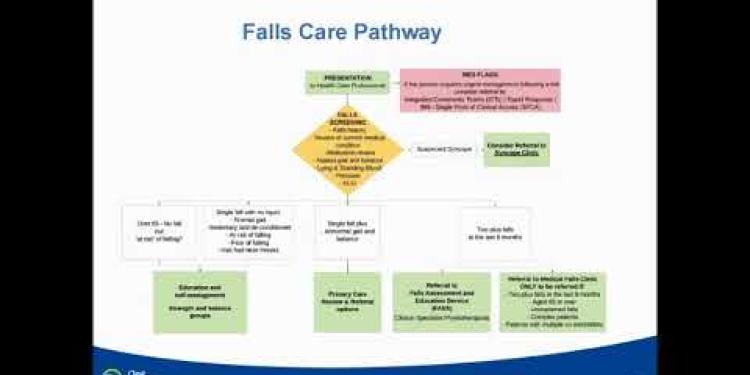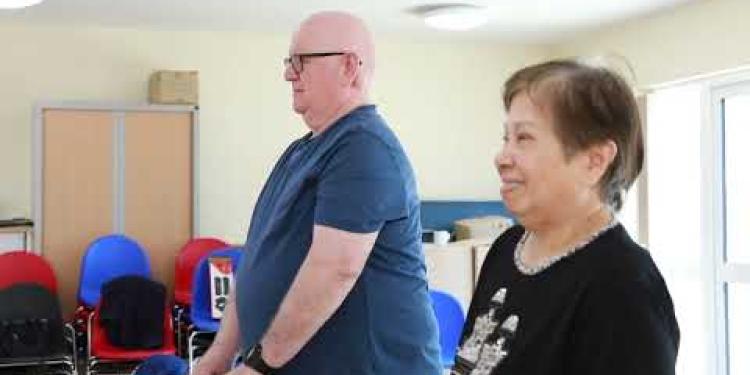Important Information On Using This Service
- Ergsy carefully checks the information in the videos we provide here.
- Videos shown by YouTube after a video has completed have NOT been reviewed by ERGSY.
- To view, click the arrow in the center of the video.
Using Subtitles and Closed Captions
- Most of the videos you find here will have subtitles and/or closed captions available.
- You may need to turn these on and choose your preferred language.
Turn Captions On or Off
- Go to the video you'd like to watch.
- If closed captions (CC) are available, settings will be visible on the bottom right of the video player.
- To turn on captions, click settings.
- To turn off captions, click settings again.
Find A Professional
More Videos of Interestdiagnosis
Falls Prevention: Strength & Balance Exercises
The Importance of Preventing Falls
Falls are a major health concern, especially among older adults in the United Kingdom. Each year, around one in three people aged 65 and over will experience a fall, which can lead to serious injuries such as hip fractures or head trauma. Implementing strength and balance exercises into your daily routine can significantly decrease the risk of falling, enhancing overall safety and well-being.
Strength Exercises
Strength exercises are essential for maintaining muscle mass, improving bone density, and ensuring overall physical resilience. Key exercises include:
- Leg Lifts: Using a chair for support, lift one leg to the side and hold for a few seconds. Repeat, alternating legs.
- Squats: Stand with feet shoulder-width apart, bend at the knees, and lower your body as if sitting back into a chair.
- Heel Raises: Stand with feet hip-width apart, rise onto your toes, and slowly lower back down.
Balance Exercises
Balance exercises help improve stability and coordination, reducing the likelihood of falls. Effective balance exercises include:
- Tai Chi: This gentle form of martial arts involves slow, controlled movements that enhance balance.
- Heel-to-Toe Walk: Walk in a straight line, placing the heel of one foot directly in front of the toes of the other foot.
- Single-Leg Stance: Stand on one leg for as long as possible, then switch to the other leg. Use a chair or wall for support if needed.
Incorporating Exercises into Daily Life
Integrating these exercises into your daily routine can be simple and practical. Set aside dedicated times each day or week to perform your strength and balance exercises. Consider joining local classes or community groups in the UK that specialise in falls prevention fitness. Always consult with your GP or a healthcare provider before beginning any new exercise regimen to ensure it is safe for your individual health needs.
Conclusion
By taking proactive steps to include strength and balance exercises in your life, you can significantly reduce the risk of falls and improve your quality of life. Stay active, stay safe, and enjoy the many benefits of a strong and balanced body.
Frequently Asked Questions
Why are strength and balance exercises important for falls prevention?
Strength and balance exercises help improve muscle strength, flexibility, and stability, reducing the risk of falls, which is especially important for older adults.
How often should I do strength and balance exercises?
It's recommended to perform strength and balance exercises at least two to three times per week to see the best results in reducing fall risk.
What are some examples of balance exercises?
Examples of balance exercises include standing on one leg, heel-to-toe walking, and Tai Chi. These exercises help you maintain stability and control.
What are some examples of strength exercises?
Strength exercises can include activities like leg lifts, squats, wall push-ups, and using resistance bands to work various muscle groups.
Do I need any special equipment for these exercises?
Many strength and balance exercises can be done without special equipment, although items like resistance bands, light weights, and stability balls can enhance the workout.
Can I do these exercises at home?
Yes, most strength and balance exercises can be performed at home with minimal space and equipment.
Is it safe to do these exercises on my own?
While many exercises can be done safely on your own, it's important to follow proper techniques and consider consulting with a healthcare provider or physical therapist, especially if you have existing health conditions.
What should I do if I feel unsteady while exercising?
If you feel unsteady, stop the exercise immediately. Ensure you have a stable support nearby, such as a sturdy chair, and consider speaking with a healthcare professional.
Can these exercises help people who have already had a fall?
Yes, strength and balance exercises can help improve recovery after a fall and reduce the likelihood of future falls by increasing strength and stability.
How long does it take to see improvements in balance and strength?
Improvements can be seen in a few weeks with consistent exercise. However, it can take a few months to see significant progress depending on the individual's starting point and frequency of exercise.
Are there exercise classes specific to falls prevention?
Yes, many community centres and health organisations in the UK offer classes specifically designed for falls prevention, focusing on strength and balance.
Is walking considered a balance exercise?
While walking is good for overall fitness, specific balance exercises that challenge your stability, such as standing on one leg or heel-to-toe walking, are more effective for improving balance.
Can these exercises benefit all ages?
Yes, while they are particularly beneficial for older adults, strength and balance exercises can help people of all ages improve their overall stability and prevent falls.
What should I wear when doing these exercises?
Wear comfortable clothing and supportive shoes that provide good grip. Avoid loose, baggy clothing that could cause you to trip.
How can I stay motivated to do these exercises regularly?
Set achievable goals, track your progress, and consider joining a group or class for social support. Regularly remind yourself of the benefits, such as reduced fall risk and improved mobility.
Useful Links
Useful links from: Preventative Care: What Your Family Needs
- NHS - Preventive Health This NHS page provides comprehensive information on various preventive health screenings, including what they entail and when you should get them.
- British Heart Foundation - Prevention & Research The British Heart Foundation offers insights on preventing heart disease through healthy living and provides research updates on heart disease prevention.
- Cancer Research UK - Cancer Prevention Cancer Research UK provides detailed information on how to reduce the risk of cancer through lifestyle choices and other preventive measures.
- Mind - How to Improve and Maintain Mental Wellbeing Mind, the mental health charity, offers tips and resources to help you improve and maintain your mental wellbeing as part of preventive care.
Useful links from: Staying Active: National Health Campaigns Promoting Physical Well-being
- NHS - Benefits of exercise NHS resource detailing the wide range of benefits associated with regular physical activity and exercise.
- NHS - Get active your way Guidelines and ideas from the NHS on how to incorporate physical activity into your daily routine in a way that suits you.
- British Heart Foundation - Staying Active The British Heart Foundation provides information and support to help people stay active and promote heart health through physical exercise.
- Macmillan Cancer Support - Physical Activity Macmillan Cancer Support offers advice and resources on how physical activity can benefit people living with cancer, including during and after treatment.
More Videos of Interestdiagnosis
Have you found an error, or do you have a link or some information you would like to share? Please let us know using the form below.
- Ergsy carfully checks the information in the videos we provide here.
- Videos shown by Youtube after a video has completed, have NOT been reviewed by ERGSY.
- To view, click the arrow in centre of video.
- Most of the videos you find here will have subtitles and/or closed captions available.
- You may need to turn these on, and choose your preferred language.
- Go to the video you'd like to watch.
- If closed captions (CC) are available, settings will be visible on the bottom right of the video player.
- To turn on Captions, click settings .
- To turn off Captions, click settings again.





